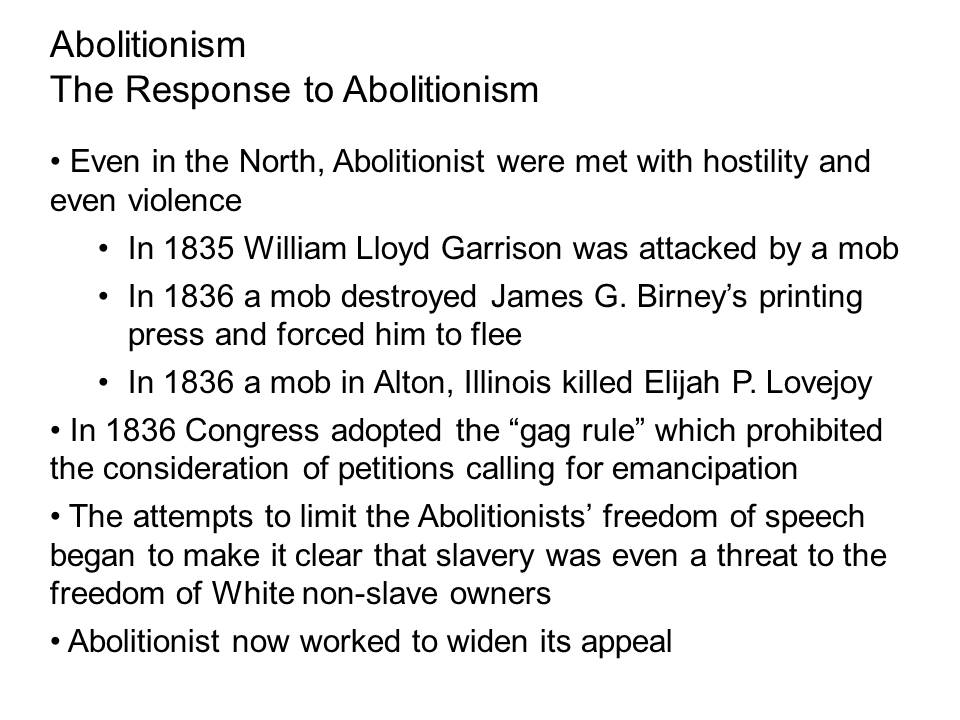Reform Movements
Introduction
- This was a time of reform, even on the international level.
- American opposed a powerful national government.
- Political and social activities were organized through voluntary organizations.
- Reformers used a variety of tactics:
- Moral suasion to convert people to their cause;
- Called for government intervention;
- Withdraw from society and create a cooperative settlement.
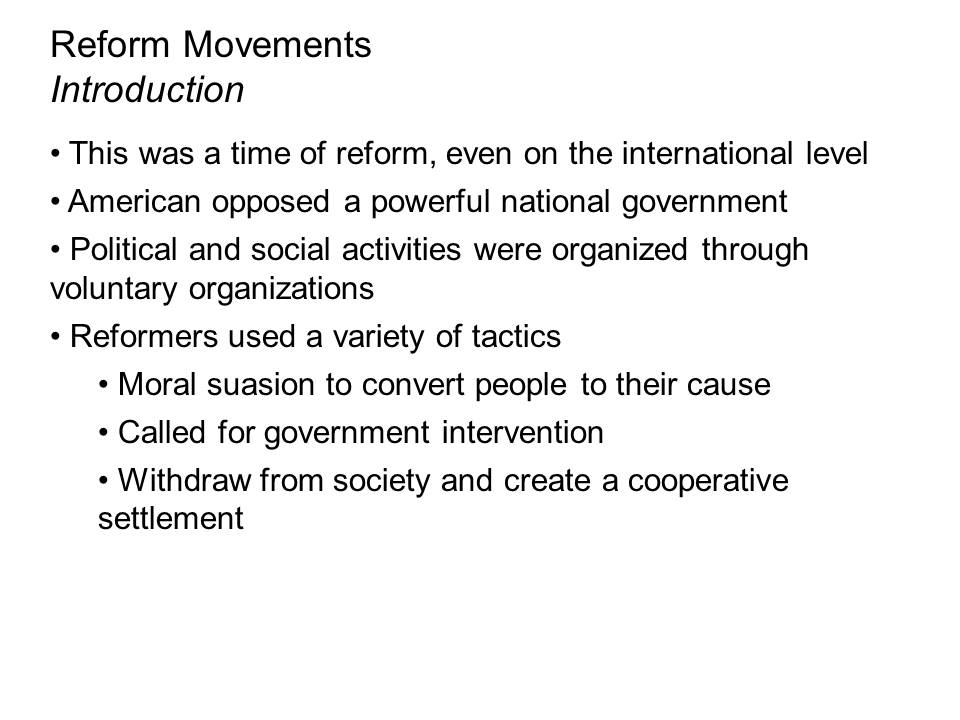
Utopian Communities
Introduction
Named after Thomas More’s novel Utopia, an outline for a perfect society. Called for the reorganization of society on a cooperative basis, hoping to restore order and harmony to a world of excessive individualism. Productive property is owned by the community rather than private individuals. Most communities called for gender equality.
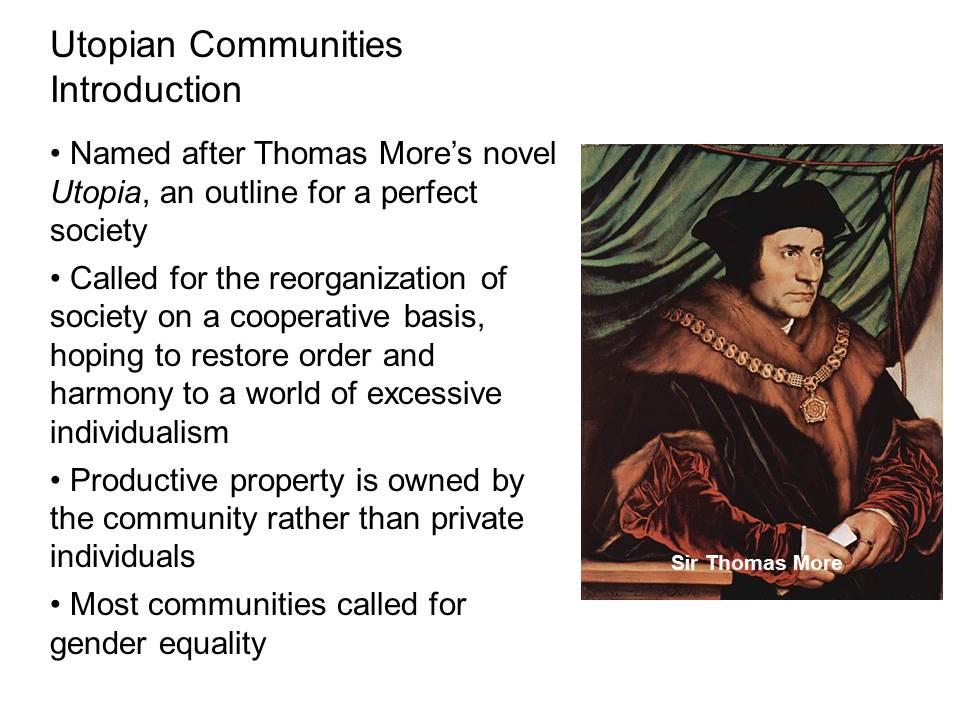
Shakers
- Founded by Mother Ann Lee who established the first Shaker community in 1787.
- Believed God a dual personality, both male and female, and thus spiritually equal.
- Abandoned traditional family life – men and women lived separately in large dormitories.
- The numbers grew by attracting converts and adopting children from orphanages rather than natural procreation.
- The group’s name comes from their religious ceremony where men and women engage in a frenzied dance.
- Rejected private property but were economically successful, including beautifully crafted furniture.
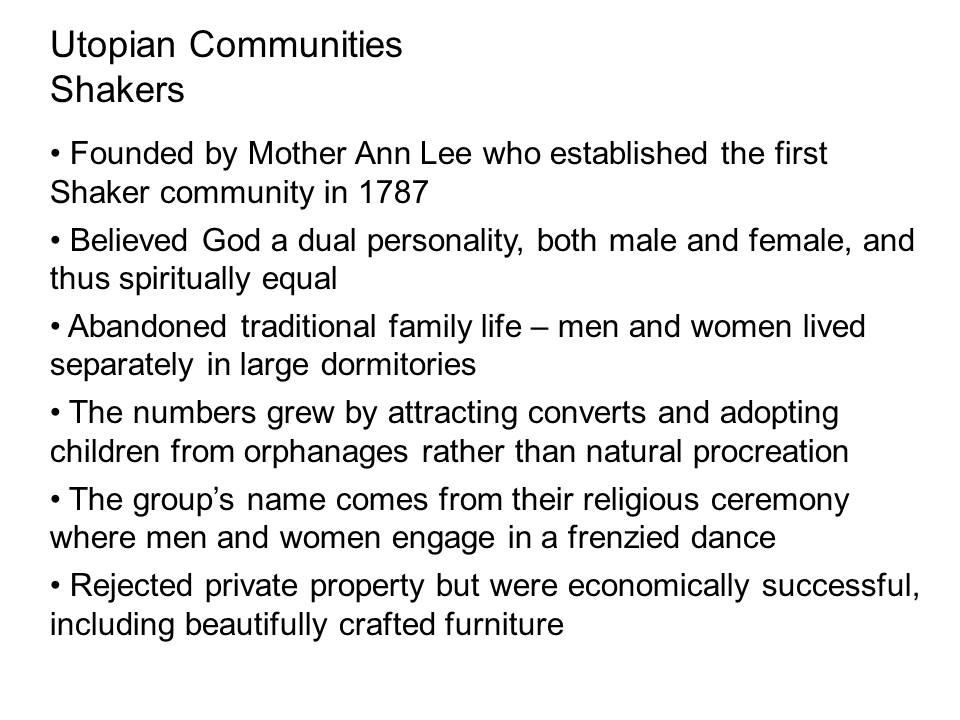
Onedida
- Founded by John Humphrey Noyes in 1848.
- Took the revivalists’ message that man could achieve moral perfection to an extreme – he and his followers were sinless.
- The community practiced “complex marriage” where any man could propose to have a relationship with any woman.
- The Oneida movement was very dictatorial.
- A committee determined which couples would be allowed to have children – a form of eugenics.
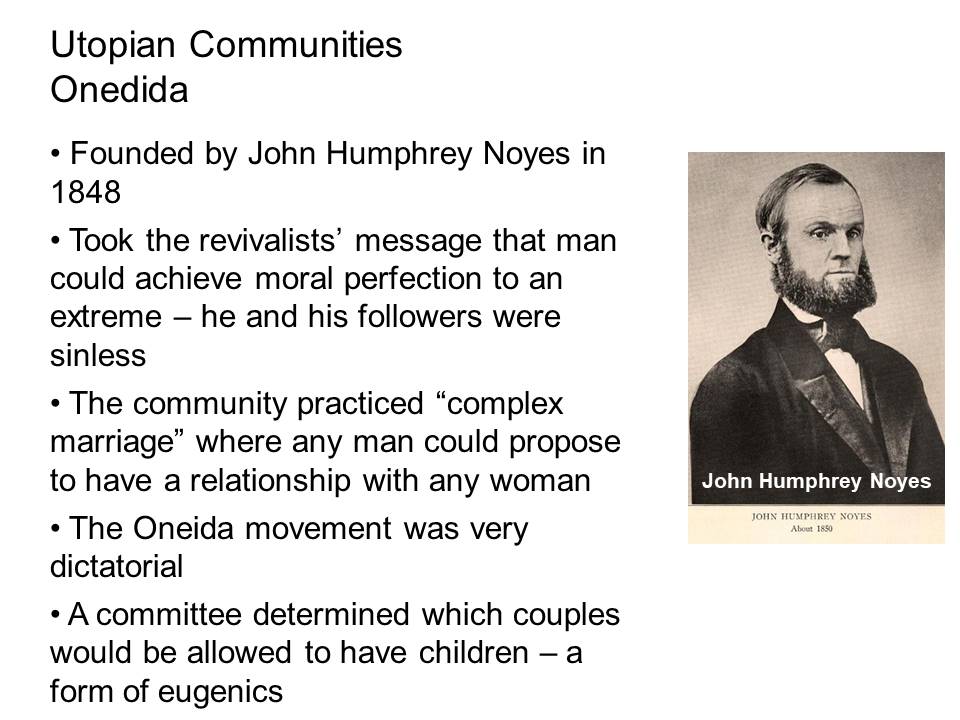
Brook Farm
- More worldly communities were also established by they lasted for a much shorter period of time.
- Brook Farm was founded by transcendentalists who argued that physical well-being was required for mental well-being.
- Modeled on the ideas of Charles Fourier which called for detail planning of the lives of residents.
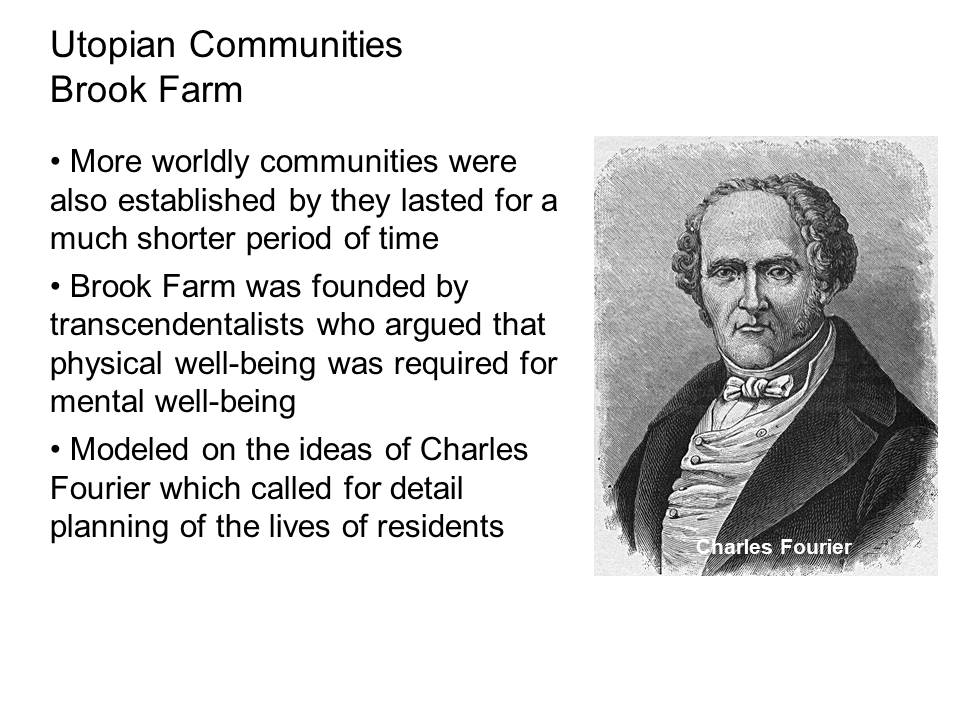
Robert Owen
- Promoted communitariansim which combined strict rules of work discipline and comfortable housing and free public education.
- Developed a model factory village in New Lanark, Scotland which became the world’s largest center for cotton manufacturing.
- In 1824, Owen purchased the Harmony Community in Indiana where he founded New Harmony.
- Argued that individuals could be transformed by changing the circumstances in which they live.
- Children were removed from their families at an early age to be schooled to subordinate individual ambition to the common good.
- Defended women’s rights including education and divorce.
- Harmony did not survive many years but had great influence.
- Labor Movement;
- Educational Reformers;
- Women’s Rights.
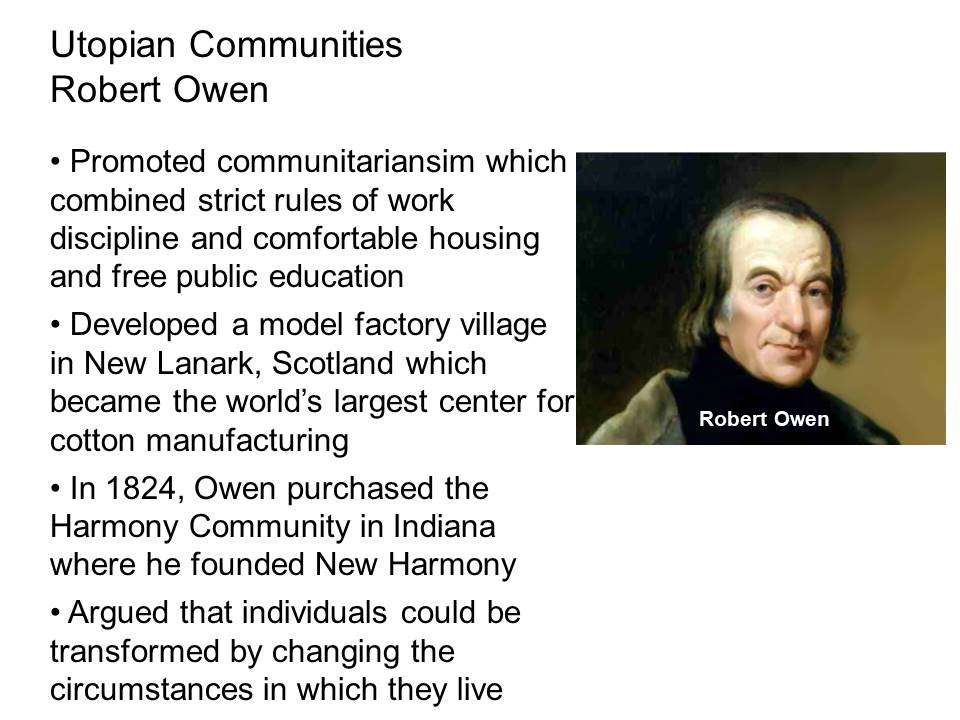
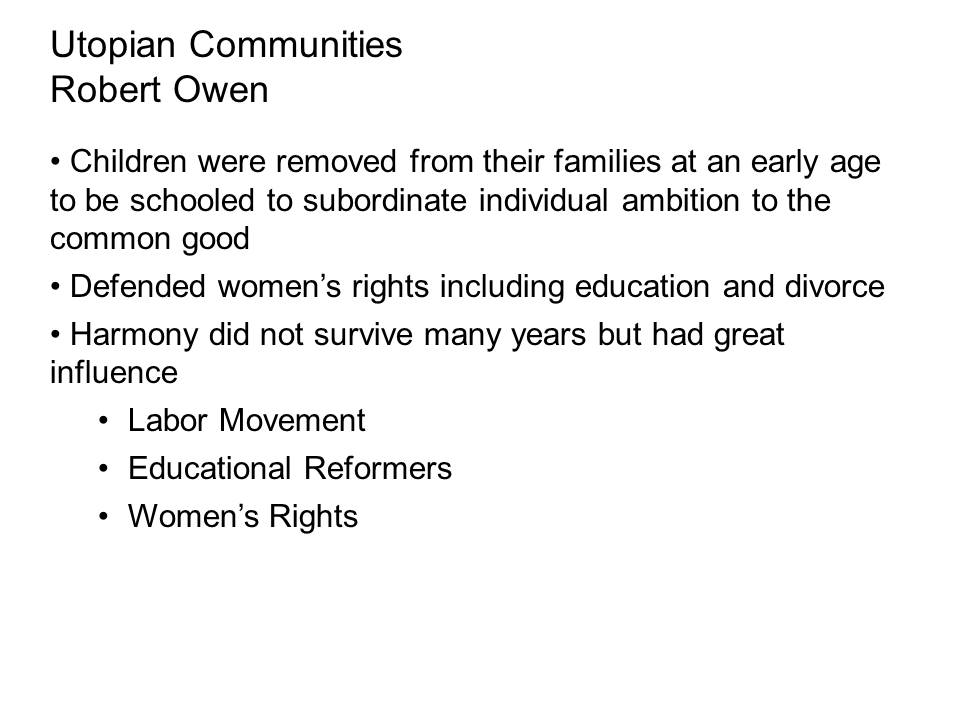
Josiah Warren
- Another approach was that proposed by anarchist Josiah Warren
- Unlike Robert Owens, Warren argued that any institution which exercises power over individuals is illegitimate
- In his communities goods were exchanged according to the work required to produce them – preventing middlemen
- Argued that marriage was purely voluntary
- Extreme individualism
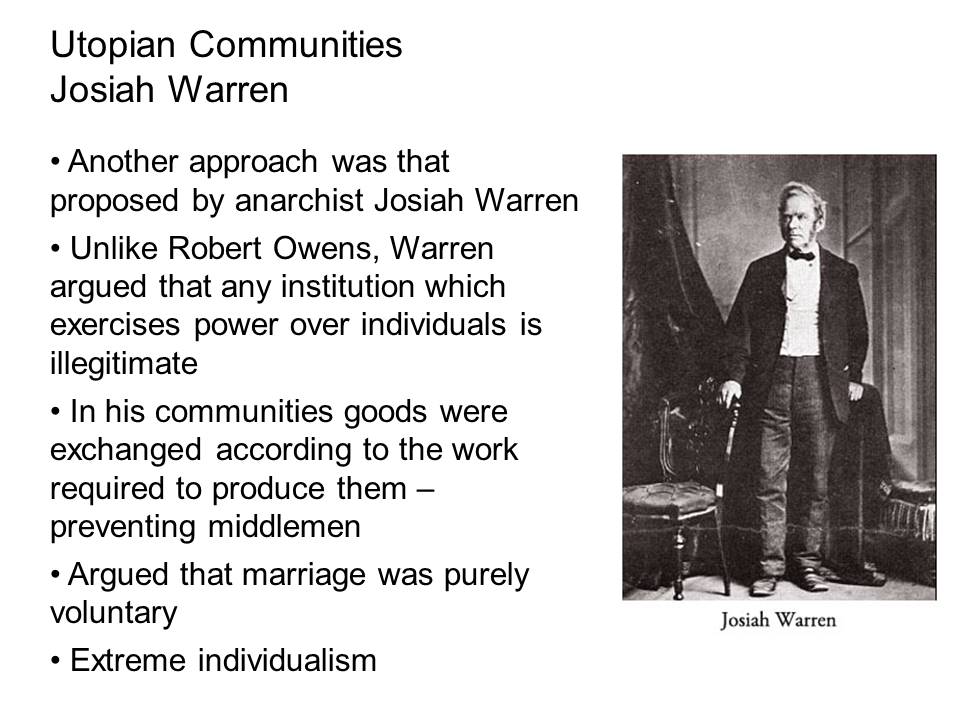
Popular Improvement
Introduction
Most Americans rejected the utopian communities because they believed that ownership of property was the foundation of personal liberty and marriage was the foundation of the social order. Many reform movements were stimulated by the Second Great Awakening which reflected an outlook of “perfectionism”. God created man to be a free moral agent who could not only reform themselves but also the wider world. Catholics viewed Protestant “perfectionism” to their religion where more emphasis is placed on authority and hierarchy than individual liberty.
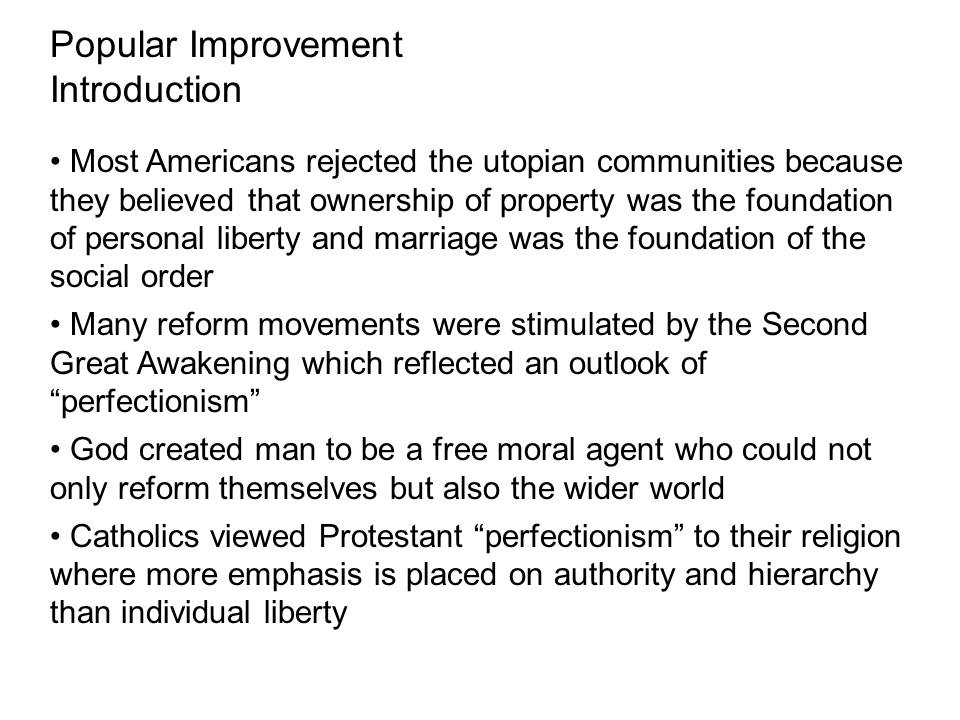
Temperance Movement
- The American Temperance Society was founded in 1826.
- Its effort was not directed against habitual drunkards but even the occasional drinker.
- Its goal was to give the individual control over their own life.
- Its effort was often associated with the anti-immigrant movements directed toward the Irish and Germans.
- The Eighteenth Amendment was passed in 1919.
- Many Americans did not welcome the effort to control their personal lives.
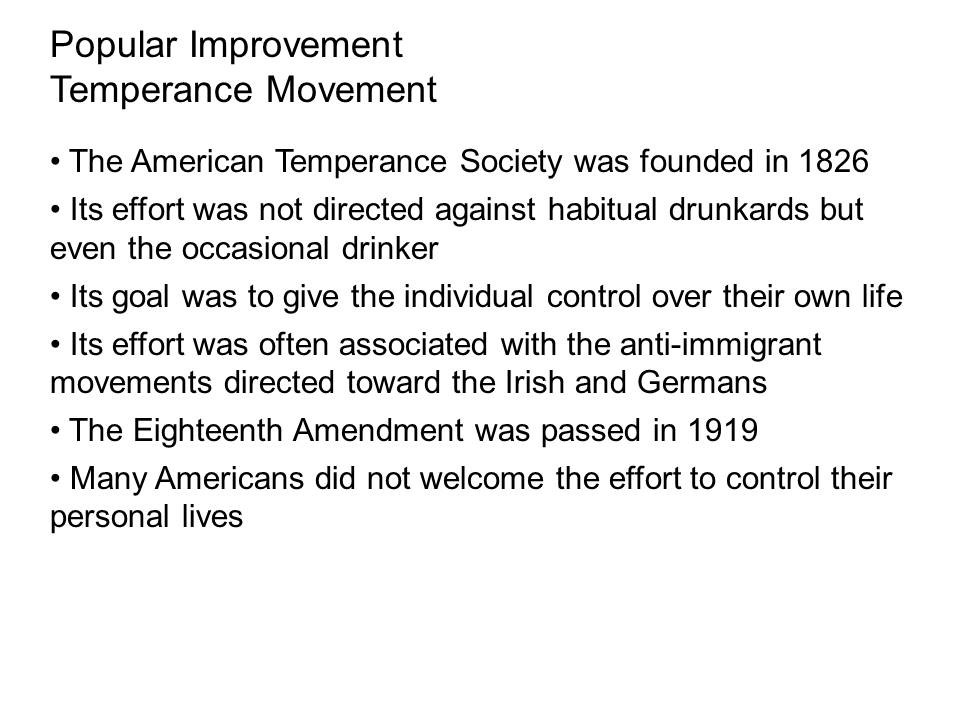
Institutions of Reform
- In the 1830 there was a rapid growth in institutions to remake or reform individual humans.
- They shared with the religious perfectionism a belief that social ills could be cured.
- Prisons were created for criminals – the purpose of Alex de Tocqueville visit to America was to study the prisons.
- Poorhouses were created for the destitute.
- Orphanages were created for children without families.
- Asylums were created for the mentally ill.
- Prisons and asylums would eventually become institutions to hold the undesirable.
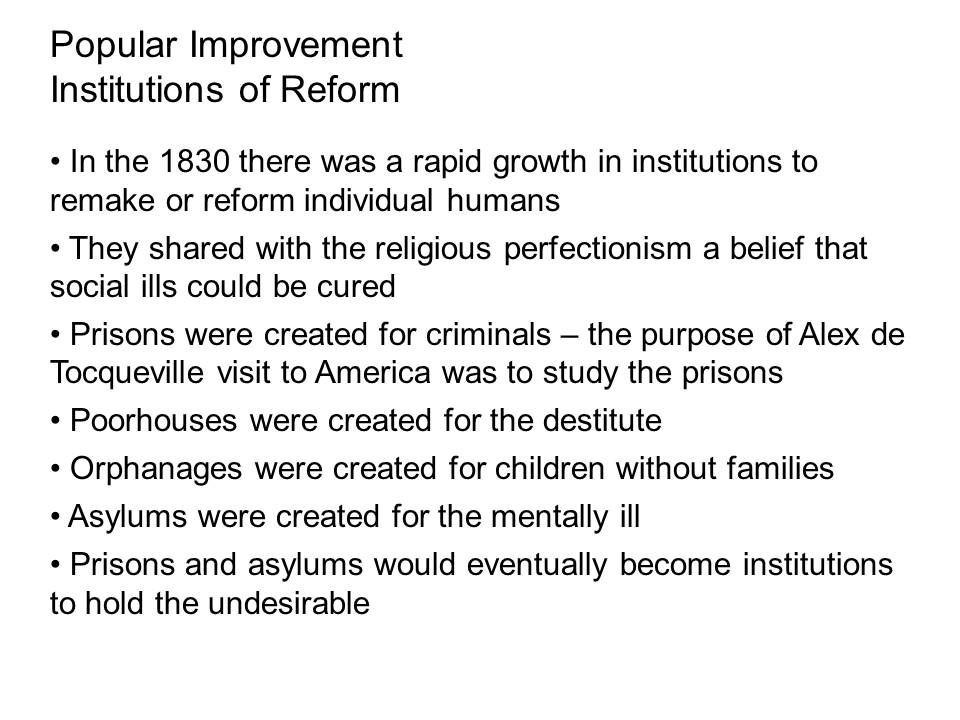
Common School
- The most successful of the institutions for reform was the common school, tax-supported state school systems.
- The leader of the movement was Horace Mann.
- Education was serve as an alternative to moving west and becoming a yeoman farmer – education was the foundation for liberty.
- The silent curriculum prepared for children to work in industry.
- Many of the first teachers were women, creating one of the few career opportunities for women.
- Some parents opposed the common school because they opposed having teachers and bureaucrats provide moral training for their children.
- Many in the South opposed being taxed to educate poor whites and viewed literate blacks as a danger to the social order.
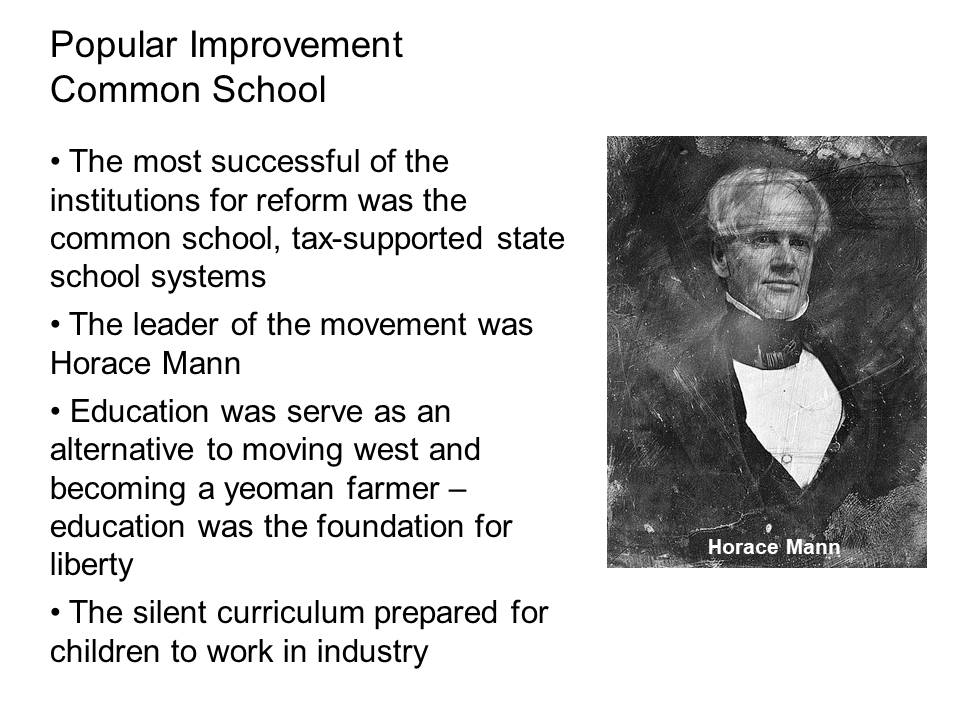
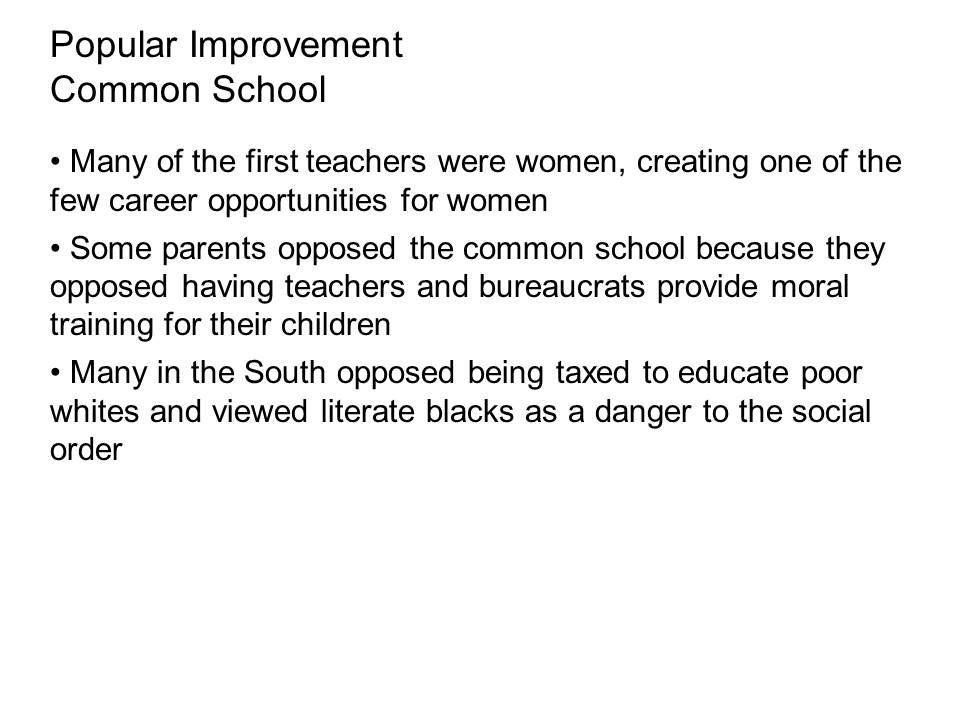
Feminism
Introduction
The reform movements were active in the public sphere. Women could not participate in government but they could participate in the public sphere where they could circulate petitions, attend meetings, and march in parades. Dorothea Dix is an example of this activity, advocating more humane treatment for the insane.
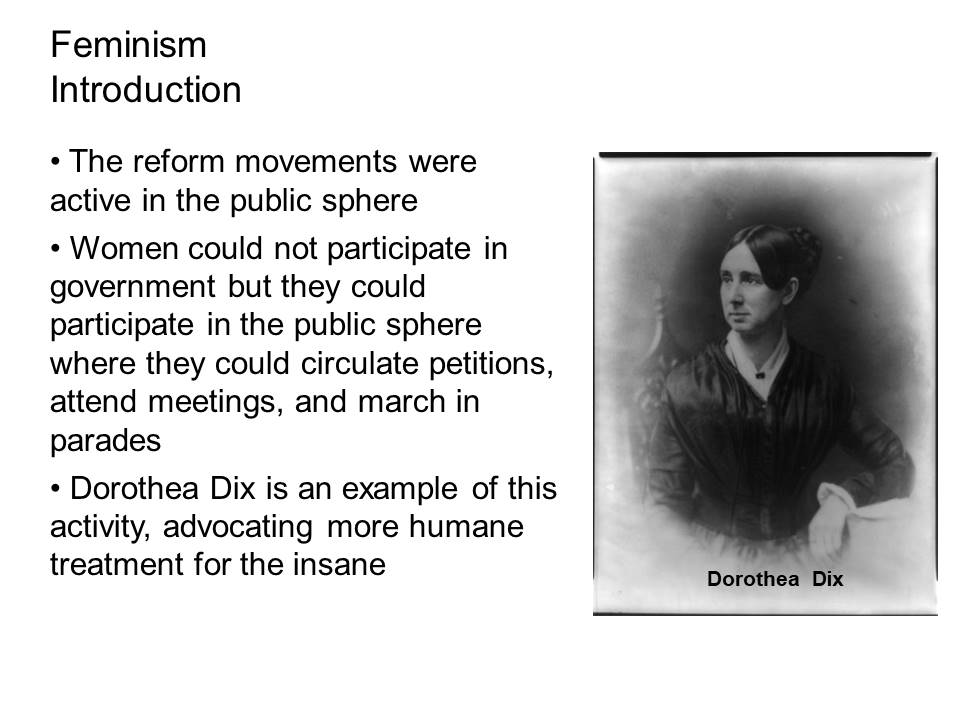
Relationship to Abolitionism
- The participation of women, such as Angelina and Sarah Grimke, in the Abolitionist movement led women to have a better understanding of their subordinate role in society.
- Converted to Quakerism, the Grinke sisters in the 1830 gave public lectures on the evils of slavery.
- Even earlier, Francis Wright and Maria Stewart, were lecturing on a wide range of subjects such as communitarianism, slavery, and labor reform.
- Sarah Grimke published Letters on the Equality of the Sexes (1838) which called for equal rights for women, including equal pay.
- The Grimke sisters were the first to apply the abolitionist doctrine of universal freedom and equality to women.
- Angelina would marry the abolitionist Theodore Weld.
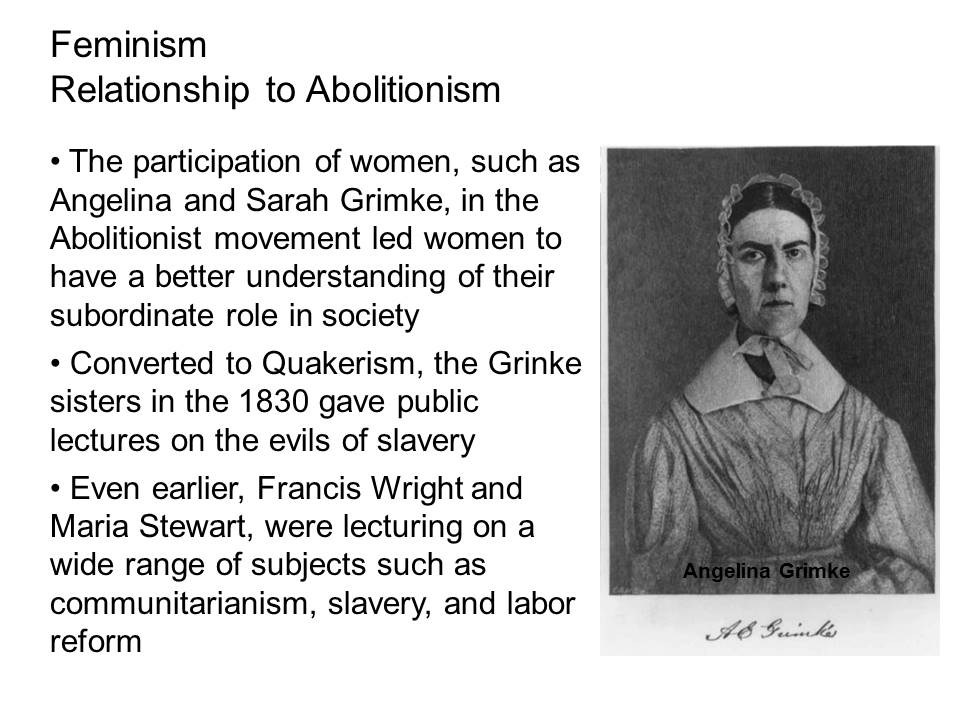
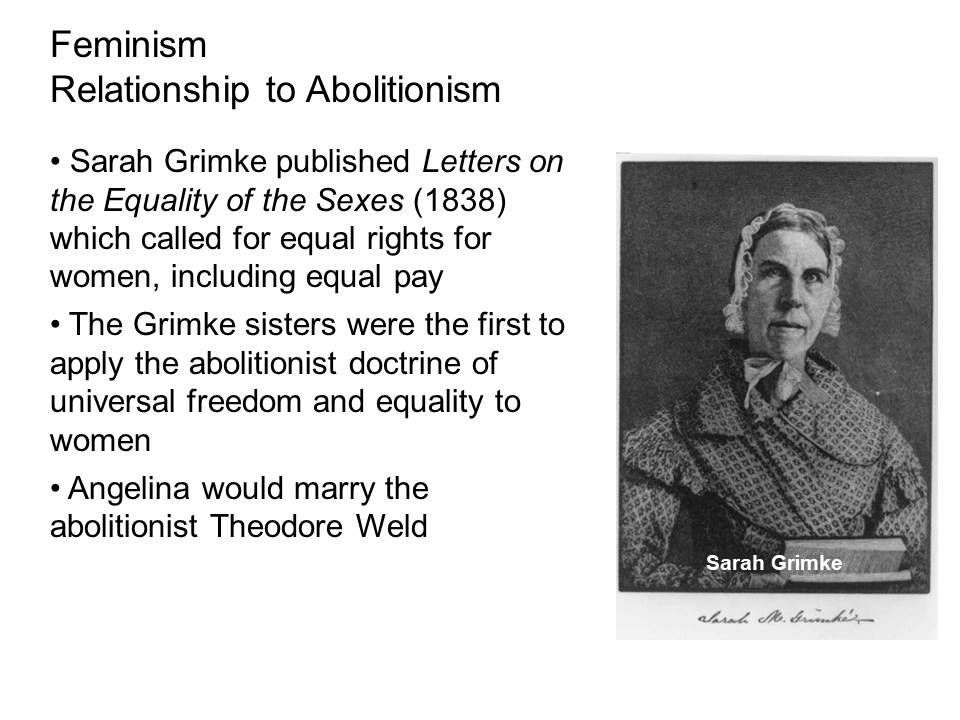
Advocates for Women’s Rights
- The Seneca Falls Convention of 1848 was organized by Elizabeth Cady Stanton and Lucretia Mott.
- The convention was the first to call for women’s suffrage – the right to vote.
- Stanton and Mott were motivated by their rejection as delegates to the World Anti-Slavery Convention of 1840.
- Like many reforms, women’s rights was an international movement.
- Margaret Fuller was a Transcendentalist who believed that freedom was a quest for personal development, whether an individual was a man or a women, Women in the Nineteenth Century (1845).
- While working in Europe as a newspaper correspondent she married an Italian rather than an American because she feared subordination.
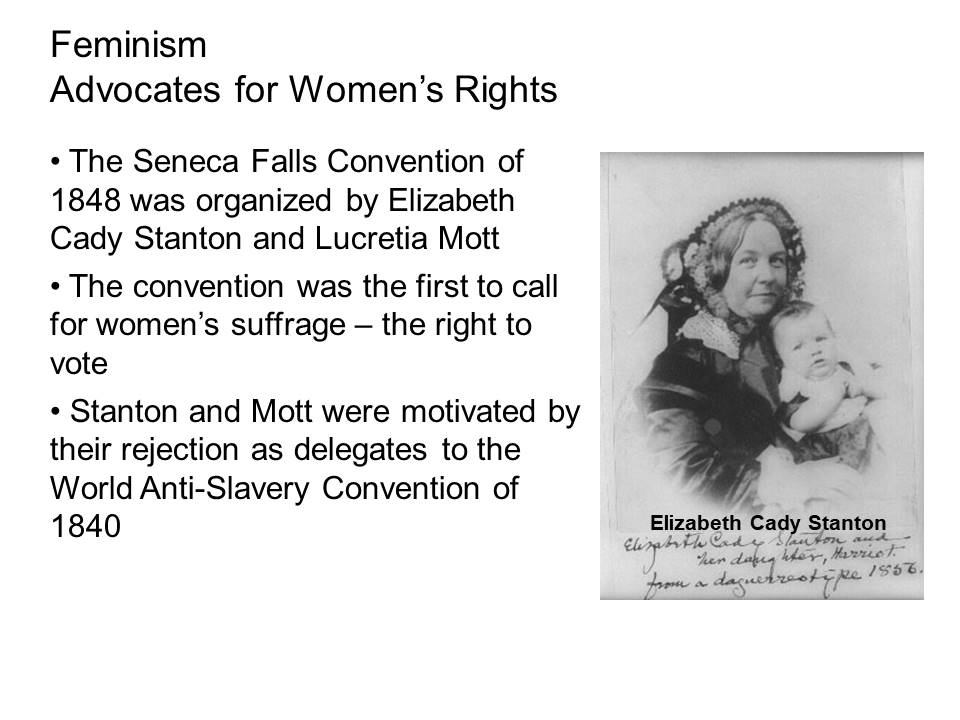
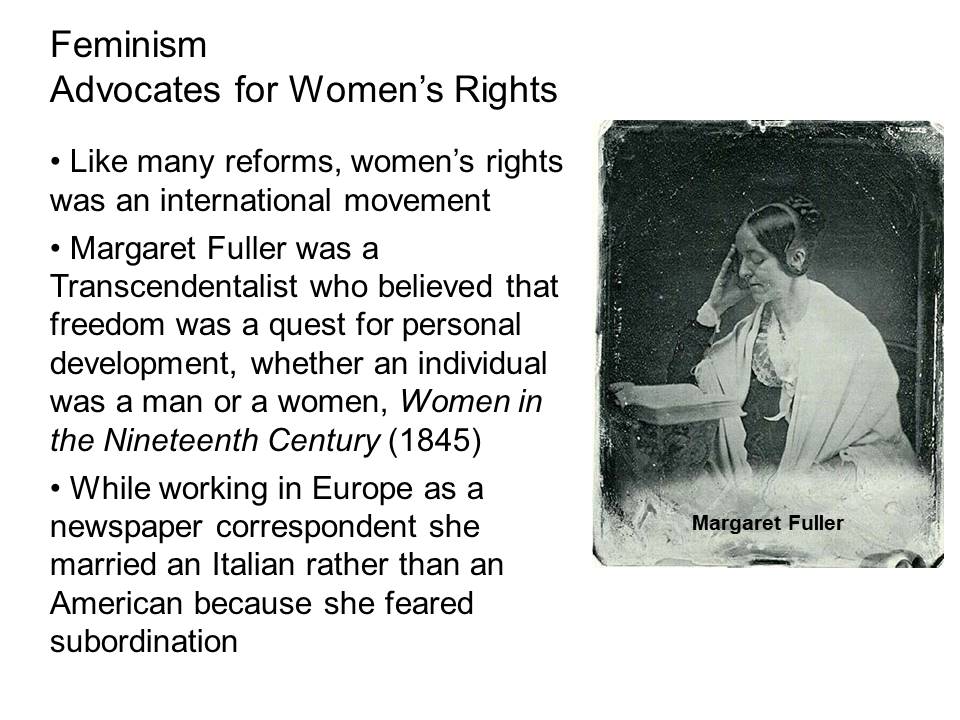
Women and the Market Economy
- Women also demanded the right to participate in the Market Economy.
- Pauline Davis argued that women must work to be emancipated from their bondage.
- Symbolic of the desire for freedom was Amelia Bloomer’s loose fitting tunic and trousers.
- The tight fitting clothes were too confining to permit women to work and participate in the public sphere.
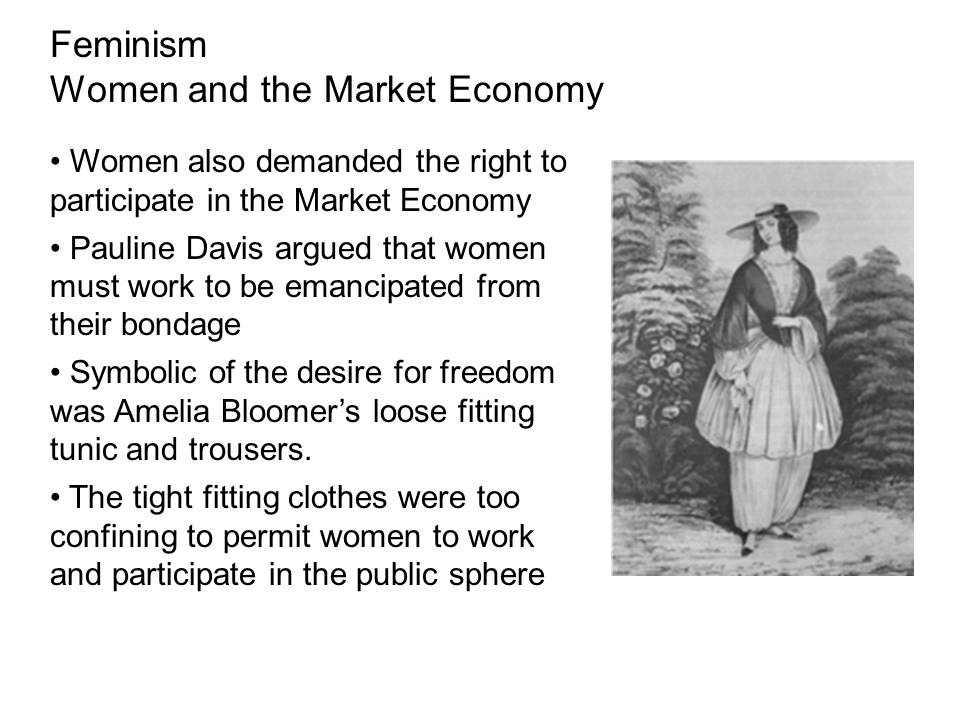
Property Rights
- Feminism attacked the idea that justice and freedom did not apply in private life and marriage.
- The status of women was increasingly compared to that of the slave.
- The association of marriage with slavery was made as early as Mary Wollstonecraft’s A Vindication of the Rights of Woman.
- Southern defenders of slavery frequently linked slavery and marriage as natural forms of inequality.
- In 1860 New York enacted laws giving married women property rights but in most states married women still did have any property rights.
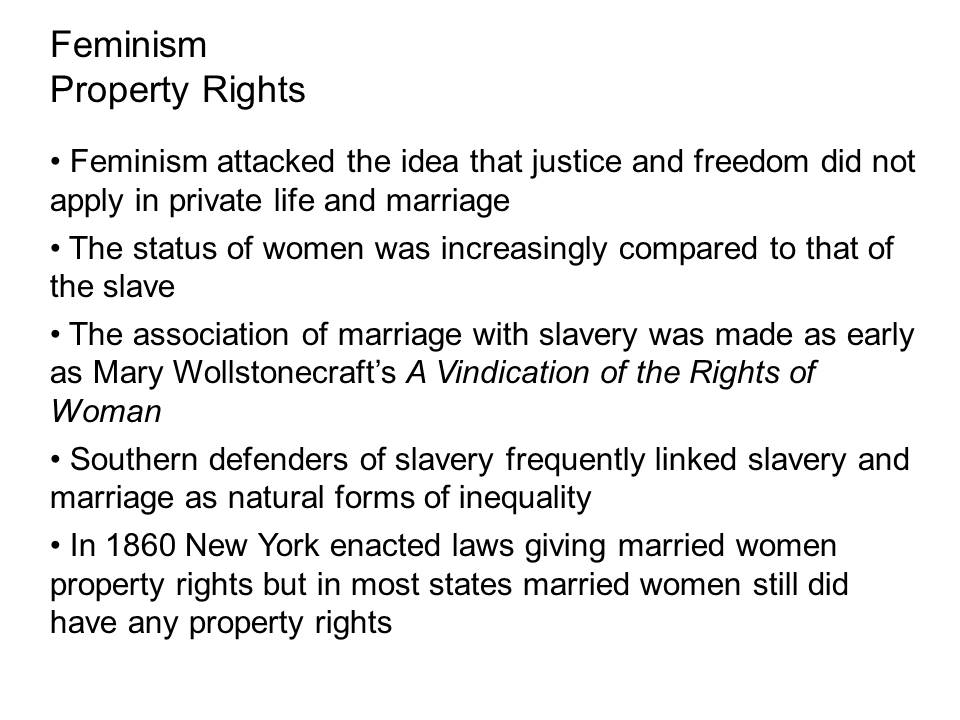
Sexual Rights
- Influenced by the growing knowledge of the sexual violation of the body of slave women, feminist called for greater control of their own body.
- Feminist called for ending laws that gave the husband the right of sexual access to his wife and license to inflict corporal punishment on her.
- Feminist claimed the right to regulate their own sexual activity and procreation.
- The issue of “private” freedom led to a split between those who accepted greater quality between the sexes and those of believed in the natural differences between the sexes.
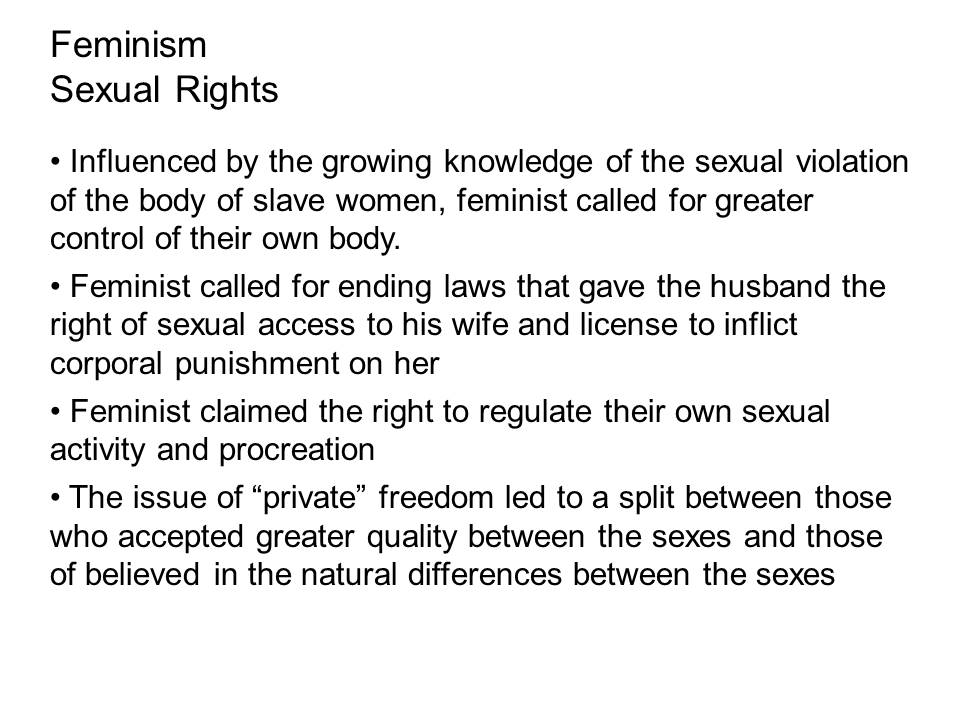
Schism with the Abolitionist
- In 1840 the American Anti-Slavery Society split over the issue of the proper role of women in the Abolitionist movement.
- Abolitionism would also soon split over the issues of abolitionist participating in politics.
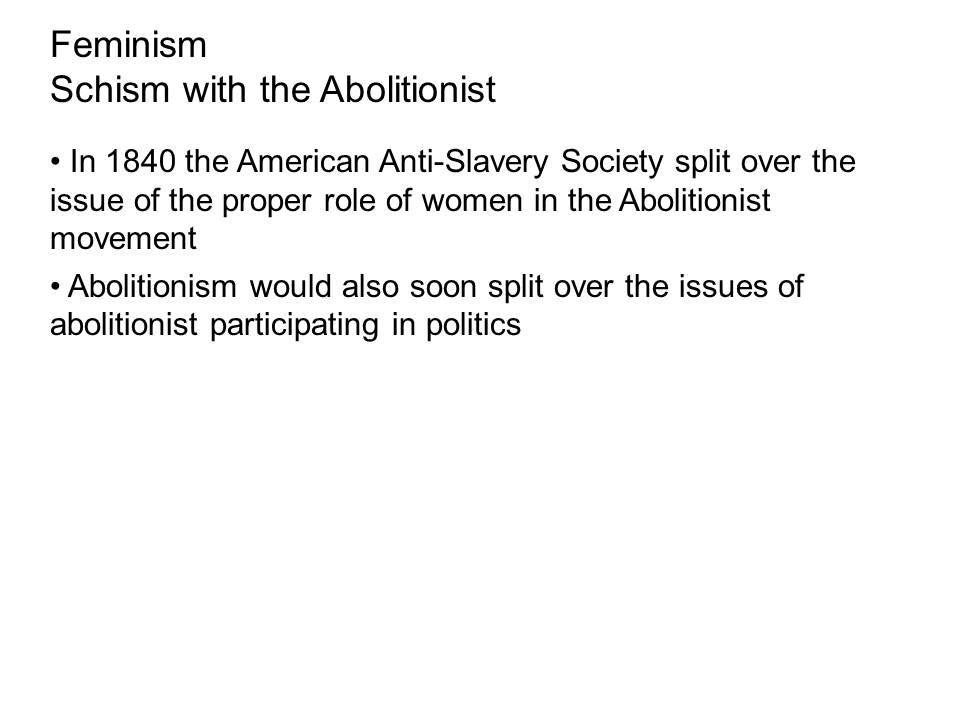
Abolitionism
Colonization
- Before 1830 abolitionism was almost always linked with colonization, returning former slaves to Africa.
- In 1816 proponents of the idea of colonization formed the American Colonization Society, which established the nation of Liberia.
- Those Southerners who supported colonization did so because they feared the presence of free Blacks.
- Life Indian removal, colonization was based on the premise that American society was destined to be a society only for Whites.
- While some freed Blacks emigrated to Liberia most opposed colonization because they believed they were entitled to the same rights as Whites.
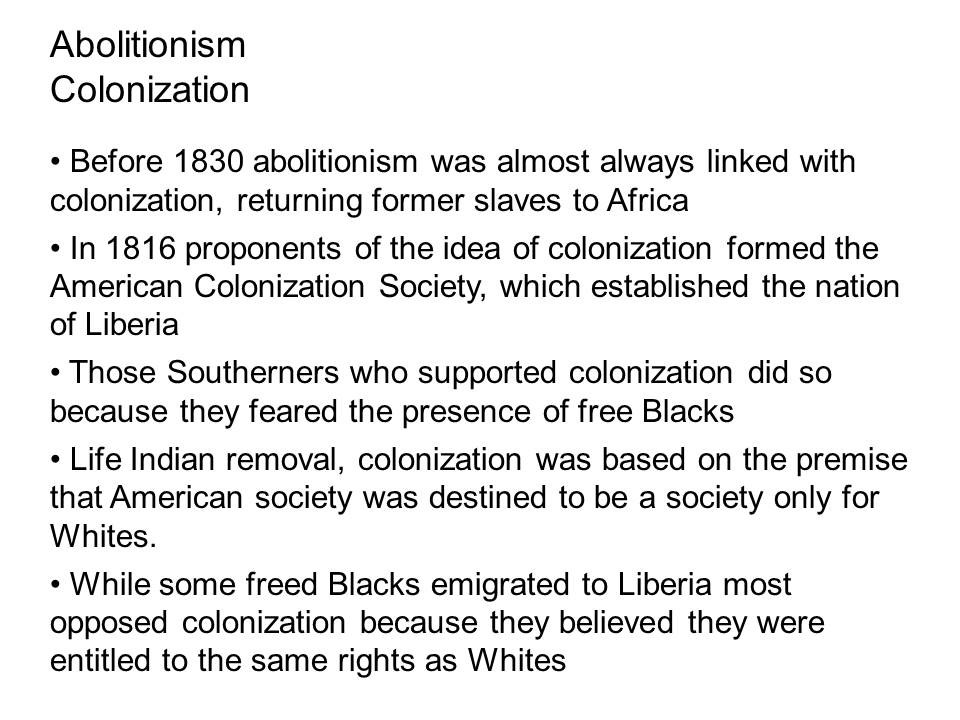
Growing Militancy
- Influenced by the religious revival of the 1830’s, slavery was viewed as a sin.
- It was also argued that slavery was contrary to the Declaration of Independence.
- Perfecting American society meant not just the end of slavery but the end of racism.
- The first to express this militancy was David Walker, a freed Black, who wrote An Appeal to the Coloured Citizens of the World (1829).

Growing Militancy – William Lloyd Garrison
- David Walker did not create an abolitionist organization.
- William Lloyd Garrison founded the newspaper, The Liberator, in 1831.
- Garrison’s inflammatory editorials provided him with notoriety and a following.
- Abolitionists used the press to appeal to the masses.
- In 1833 the American Anti-Slavery Society was formed and by 1840 more than 100,000 Americans had joined location groups of abolitionists.
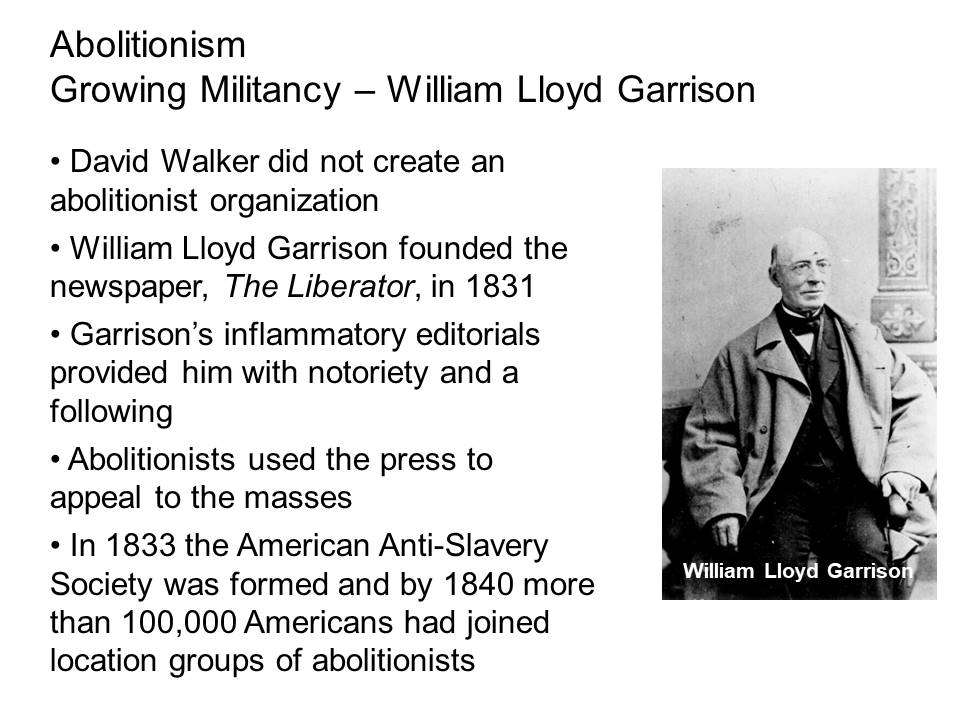
Growing Militancy – Theodore Weld
- Theodore Weld played a leading role in developing a mass constituency for abolitionism.
- Weld was a young minister converted by Charles G. Finney.
- Weld was a brilliant speaker and he trained a group of speakers to carry the abolitionist message to the nation.
- Used the same method as the revivalists – slavery was a moral issue.
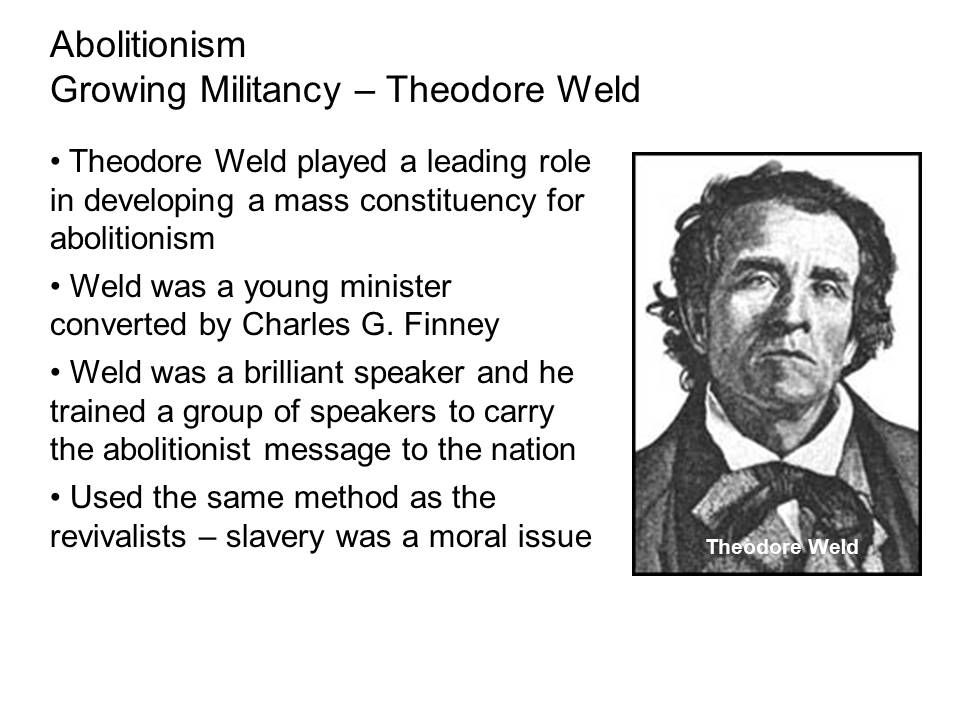
Moral Suasion
- Most abolitionists were pacifists or non-resistors who believed that coercion should be eliminated from all human relationships and institutions.
- Trying to appeal to the masses, their language was meant to be provocative but not violent.
- Some critics argue the abolitionists left Black slaves no means for achieving their own freedom – they were dependent on Whites (paternalism).
- Argued that the right of personal freedom took precedence of other forms of freedom such as property rights.
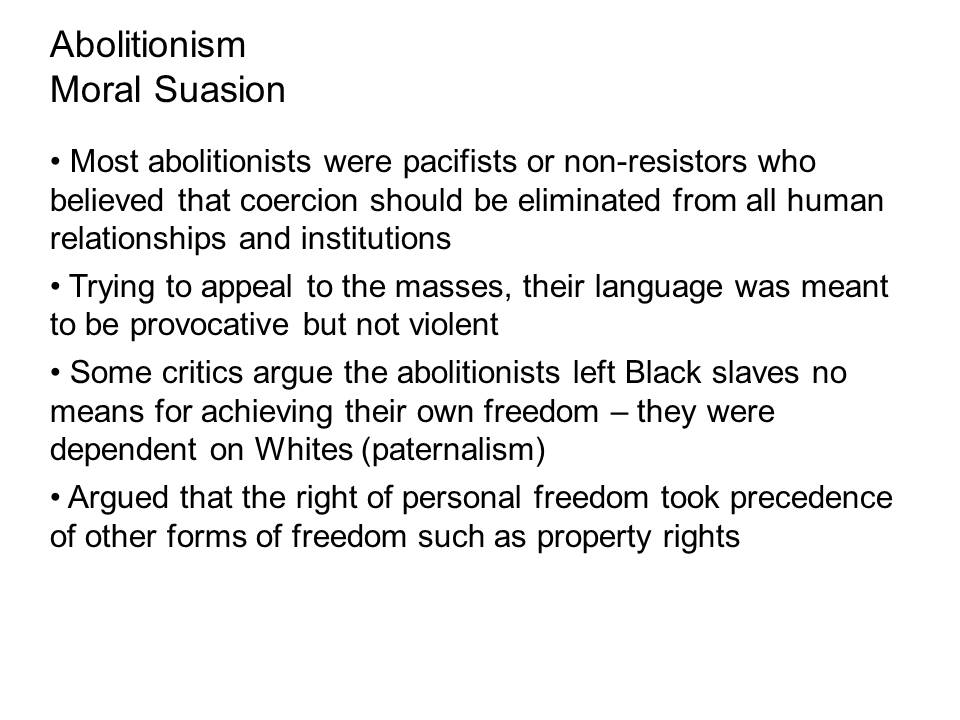
Vision of Freedom
- The abolitionist challenged the idea that the rights of citizenship was based upon race.
- This concept would later be adopted in the Fourteenth Amendment.
- Abolitionist worked to popularize the Declaration of Independence rather than the Constitution as the foundation of the nation.
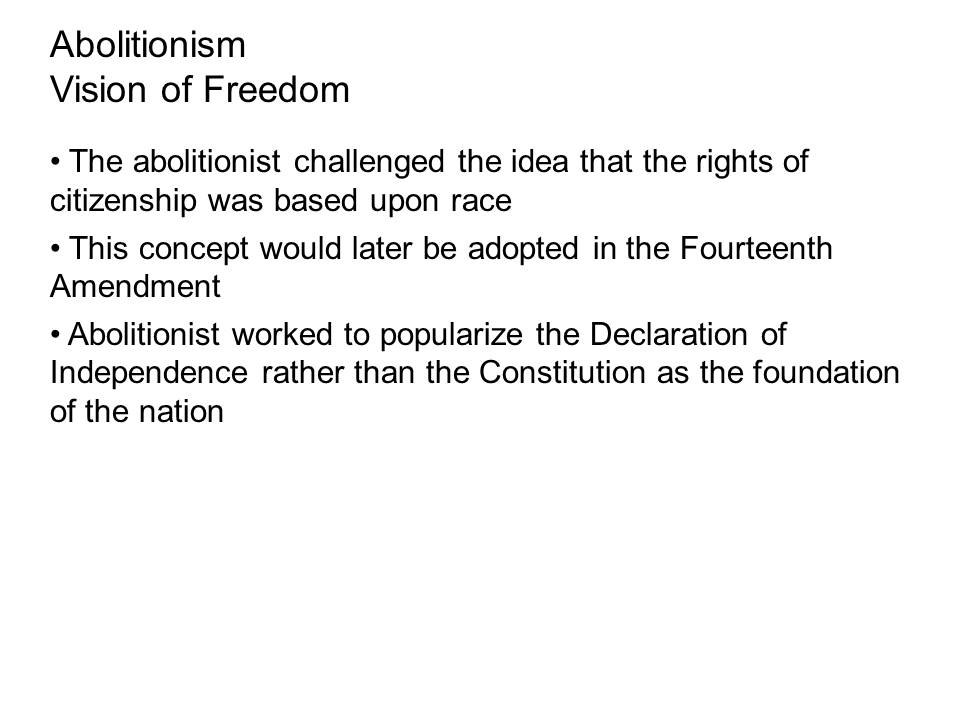
Blacks and Abolitionism
- The abolitionist challenged the idea that the rights of citizenship was based upon race.
- This concept would later be adopted in the Fourteenth Amendment.
- Abolitionist worked to popularize the Declaration of Independence rather than the Constitution as the foundation of the nation.
- Frederick Douglas was a former slave who published an account of his life as a slave.
- Harriet Beecher Stowe’s Uncle Tom’s Cabin portrayed the life of slavery was based upon the autobiography of Josiah Henson.

Race and Abolitionism
- Many White Abolitionist could not free themselves from the racism that was pervasive in the nation.
- White Abolitionist monopolized all key positions in the movement.
- By the 1840’s Blacks had formed their own organizations and often called for slaves to rebel.
- Many Abolitionist did work to end racial discrimination in the North.
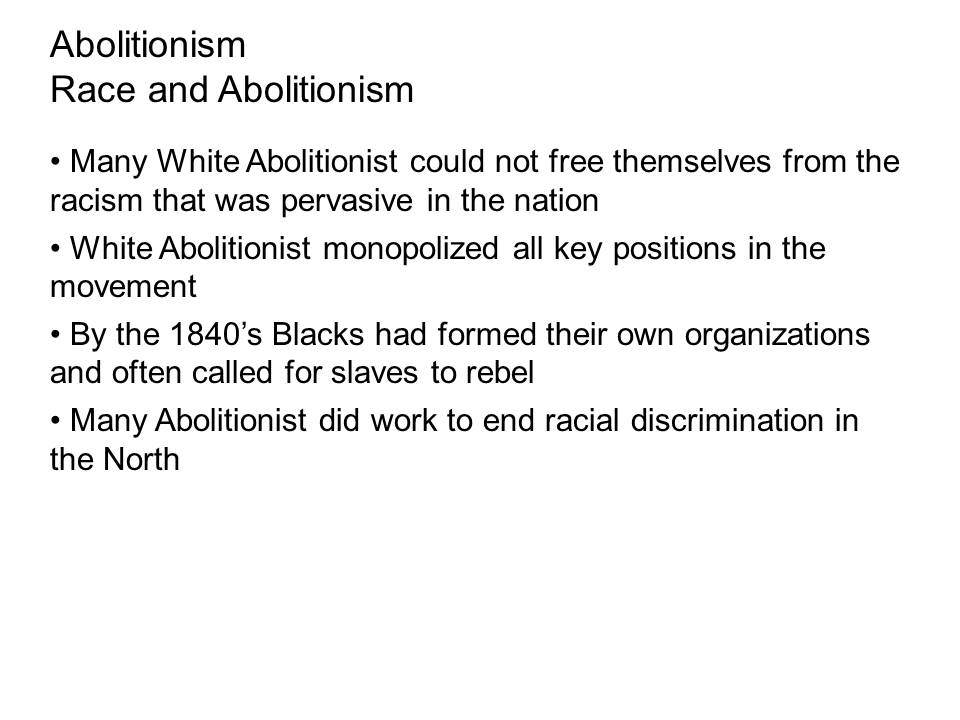
Ideals and Philosophy of Black Abolitionists
- Challenged the association of the United States with freedom and progress.
- Many praise Great Britain which outlawed slavery.
- Articulated the idea of color-blind citizenship.
- Also called for greater economic opportunities.
- Led claim to the legacy of the Declaration of Independence.
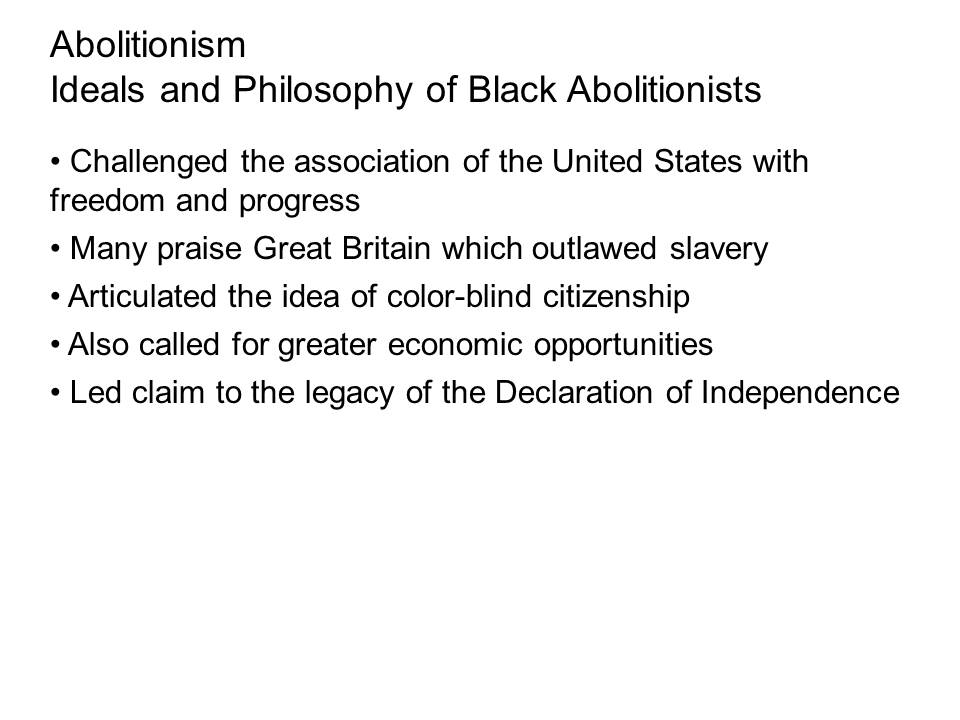
The Response to Abolitionism
- Even in the North, Abolitionist were met with hostility and even violence.
- In 1835 William Lloyd Garrison was attacked by a mob.
- In 1836 a mob destroyed James G. Birney’s printing press and forced him to flee.
- In 1836 a mob in Alton, Illinois killed Elijah P. Lovejoy.
- In 1836 Congress adopted the “gag rule” which prohibited the consideration of petitions calling for emancipation.
- The attempts to limit the Abolitionists’ freedom of speech began to make it clear that slavery was even a threat to the freedom of White non-slave owners.
- Abolitionist now worked to widen its appeal.
